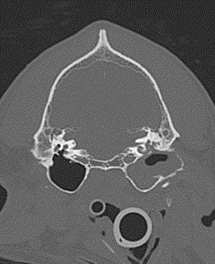What is a TECA?
TECA surgery involves surgical removal of the entire ear canal, and is usually performed in conjunction with a lateral bulla osteotomy (LBO). An LBO involves widening the entrance into the middle ear in order to remove any fluid, infection or tissue contained within. The visible external ear (pinna) is left in place.
Why do we need to perform TECA surgery?
TECA surgery is most commonly performed in patients with middle ear disease or chronic otitis which is non-responsive to medical management, but can also be performed in patients in order to remove polyps or tumours.
Otitis is a common condition in dogs and usually occurs because of inflammation of the skin which lines the ear canal and can result in secondary infection of both the ear canal and the middle ear nflammation of the skin lining the ear canals is often part of a more generalised skin condition. Simple cases usually respond well to medical management, but chronic cases can result in irreversible narrowing of the ear canal and infection of the middle ear. Otitis is a painful condition, and the discomfort caused by ear disease is often hard to recognise as these conditions are often so long standing.
Patients referred to us for TECA surgery will undergo a CT scan initially to allow us to assess the extent of change within the ear canal. CT images also allow us to assess the middle ear, which is not possible to visualise on physical examination. Patients with middle ear disease often have a combination of fluid and thickened mucosa within the bulla of the middle ear. These cases will usually require surgery. Patients with external ear disease, but no evidence of middle ear disease, will often be referred to a dermatologist in order to try to treat the disease process without surgery. Approximately 50% of these patients will respond to appropriate medical management, whilst the other 50% will require surgery.

This CT image shows a dog who subsequently underwent a TECA.
On the left of the image his bulla is normal - it appears black inside because it is filled with air. On the right it is grey, with only a small, black air pocket as it is full of debris.
What happens after surgery?
TECA surgery involves removal of the ear canal, and so will result in reduced hearing. However the inner ear remains intact, and patients often appear to retain some hearing, similar to that when wearing ear plugs.
Patients will remain in the hospital overnight for pain relief and monitoring, but most are discharged home the following day. It is essential that patients wear a protective buster collar to prevent them from interfering with the surgical wound for the first 10-14 days post-operatively.
Chronic otitis is often a progressive condition, and the signs of chronic pain and discomfort can be hard to detect. The majority of patients who undergo TECA surgery show a dramatic improvement in their demeanor within the first 7-10 days following surgery.
What are the potential complications?
The majority of TECA surgeries result in success and a greatly improved level of comfort and quality of life, some complications can, on occasion, be seen. These include:
- Reduced hearing
- Facial nerve paralysis; reported to occur in 10-20% of cases, however the majority of these cases are temporary. Paralysis results in drooping of the upper eyelid and reduced ability to blink. Any paralysis which persists 6 weeks after the surgery are likely to be permanent.
- Haemorrhage; due to the close proximity of several large vessels, significant bleeding can occur during surgery, however all measures are taken to reduce this risk as much as possible.
- Infection; operating in an area of chronic infection can result in post-operative infection or abscess formation which can take several years to appear. Some of these cases can be difficult to manage, and may require further surgery.
- Vestibular syndrome; TECA surgery requires us to operate very close to the region responsible for balance, and in some cases due to the extent of the disease damage to this area is unavoidable. Patients affected develop issues with their balance, however most of these will improve in the immediate post-operative period.